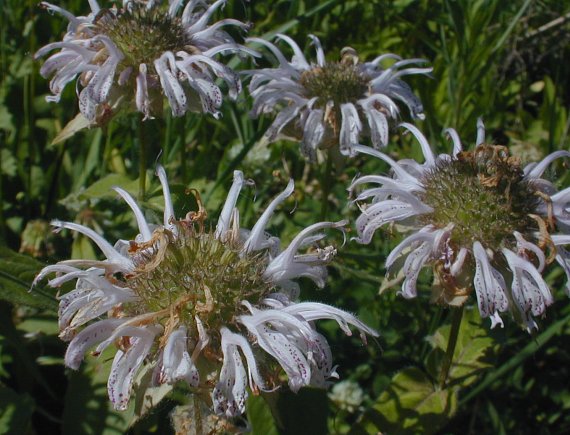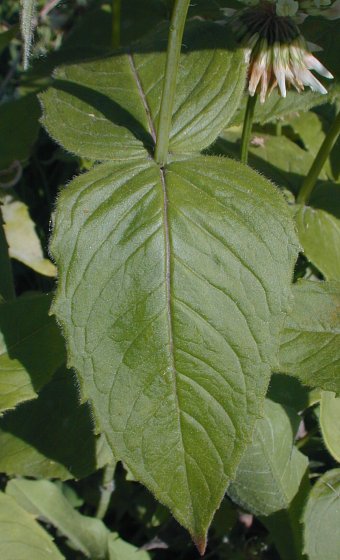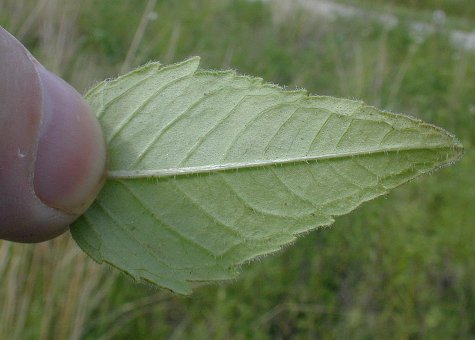Description: This herbaceous perennial plant is 1-2' tall, branching occasionally. The stems are sharply 4-angled and usually glabrous, although scattered hairs may occur along the ridges on relatively new growth. The opposite leaves are up to 3½" long and 2" across. They are sessile against the stem, or have very short petioles. The leaves are broadly lanceolate or ovate, with serrate margins that are often ciliate. The upper surface of each leaf is often finely pubescent, while a few hairs may occur along the major veins on the lower surface. The upper surface is green or yellowish green, sometimes with scattered purple spots or a purplish tint along the margin. The upper stems terminate in dome-shaped flowerheads (a single flowerhead per stem). These flowerheads are about 1½–3" across. A small wreath of flowers first appears toward the center of the flowerhead, and spreads gradually towards the outer edge of the flowerhead.

Each narrow flower
is about 1" long, and has a corolla that is deeply divided into
prominent upper and lower lips. The upper lip is nearly tubular and
contains the exerted stamens, while the lower lip is somewhat wider and
has a narrow lobe at its tip that curls downward. The corolla is white
or pink, with purple dots on the lower lip, and white hairs on the
upper lip. The calyx of each flower is tubular and hairy, with 5
pointed lobes at its tip. Immediately beneath each flowerhead are 5
leafy bracts that are triangular-shaped. These bracts often have
ciliate margins, and they are often colored faded pink or purple. The
blooming period occurs during the late spring or early summer and lasts
about a month. There is no floral scent, although the foliage exudes an
oregano scent. The nutlets are dispersed to some extent by the wind.
The root system produces abundant rhizomes, enabling vegetative
reproduction.
Cultivation:
The preference is partial sun and somewhat dry conditions. This species
often grows in soil that is somewhat thin and rocky, which reduces
competition from other species of plants. The lower
leaves will fall off the stems during drought; in stressed-out
plants, the foliage may become discolored and diseased.

Range
& Habitat: The native Bradbury's Bee
Balm occurs occasionally in the southern half of Illinois, while
elsewhere within the state it
is rare or absent (see Distribution
Map). Habitats include rocky upland forests, savannas,
thickets, limestone or sandstone glades, bluffs, meadows in wooded
areas, pastures, and roadsides. This species probably benefits from
occasional wildfires to create clearings in woodland areas.
Faunal Associations:
Long-tongued bees (especially bumblebees), butterflies, skippers,
Hummingbird moths, beeflies, and hummingbirds visit the flowers for
nectar. The small black bee Doufourea monardae is a
specialist pollinator of Monarda spp. Short-tongued
Halictid bees may visit the flowers to collect pollen; they are unable
to reach the nectar. Caterpillars of the moths Sphinx eremitus
(Hermit Sphinx), Anterastria teratophora
(Gray Marvel), Pyrausta
orphisalis (Pyralid Moth sp.), and Pyrausta signatalis
(Pyralid Moth sp.) feed destructively on Monarda spp. (Bee
Balms). Other insect feeders include the scentless plant bug Arhyssus nigristernum,
the leaf-footed bug Euthochtha
galeator, the aphid Hyalomyzus
monardae, and the leaf beetle Physonota unipunctata.
Mammalian herbivores usually avoid consumption of Monarda spp.
– it is possible that the oregano scent of the foliage deters them.

Photographic
Location:
An upland savanna at Warbler Woods in Coles County, Illinois, and a
restored prairie at Meadowbrook Park in Urbana, Illinois.
Comments:
Bradbury's Bee Balm is fairly easy to identify. Like other Monarda
spp., the large flowers have a distinctive appearance that is
showy and attractive. Bradbury' Bee Balm differs from other Monarda
spp. in Illinois by its sessile or nearly sessile leaves, and
the purple dots on the lower lip of the corolla. It is also shorter in
stature and blooms earlier. The species Monarda russeliana
of some authors is probably the same species as Monarda
bradburiana.